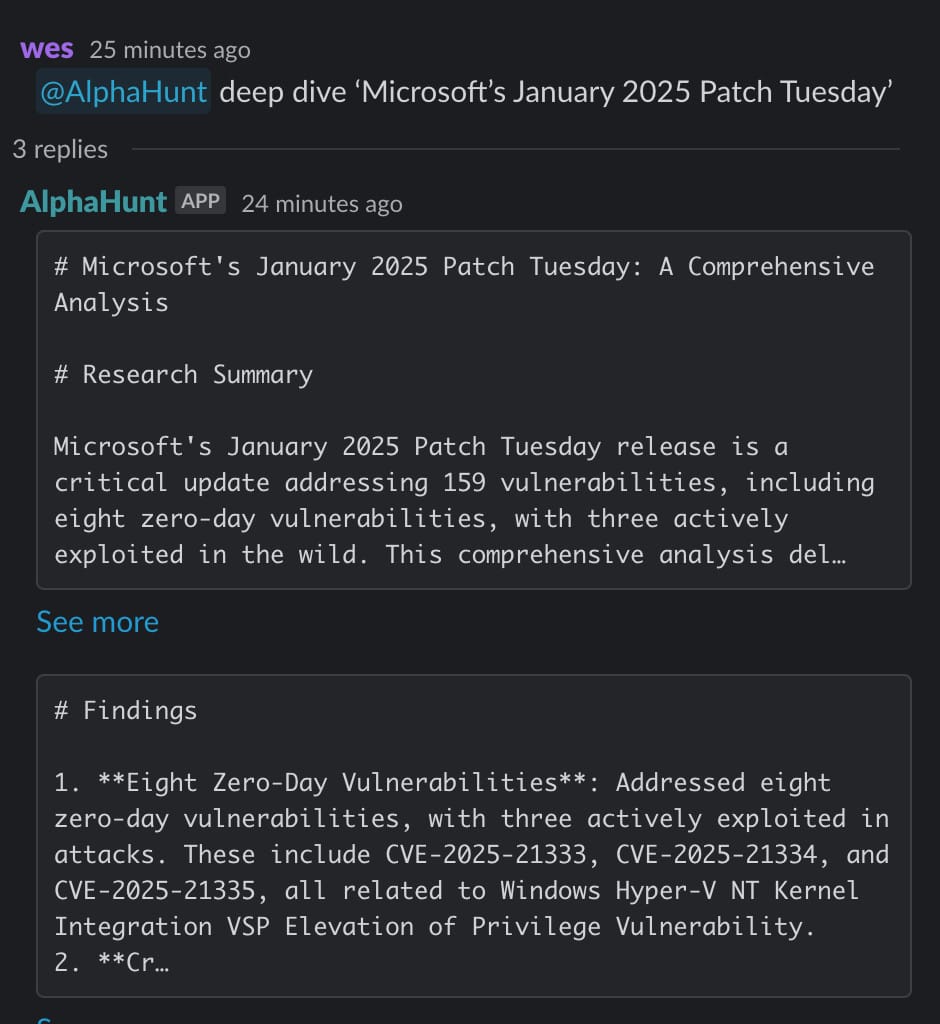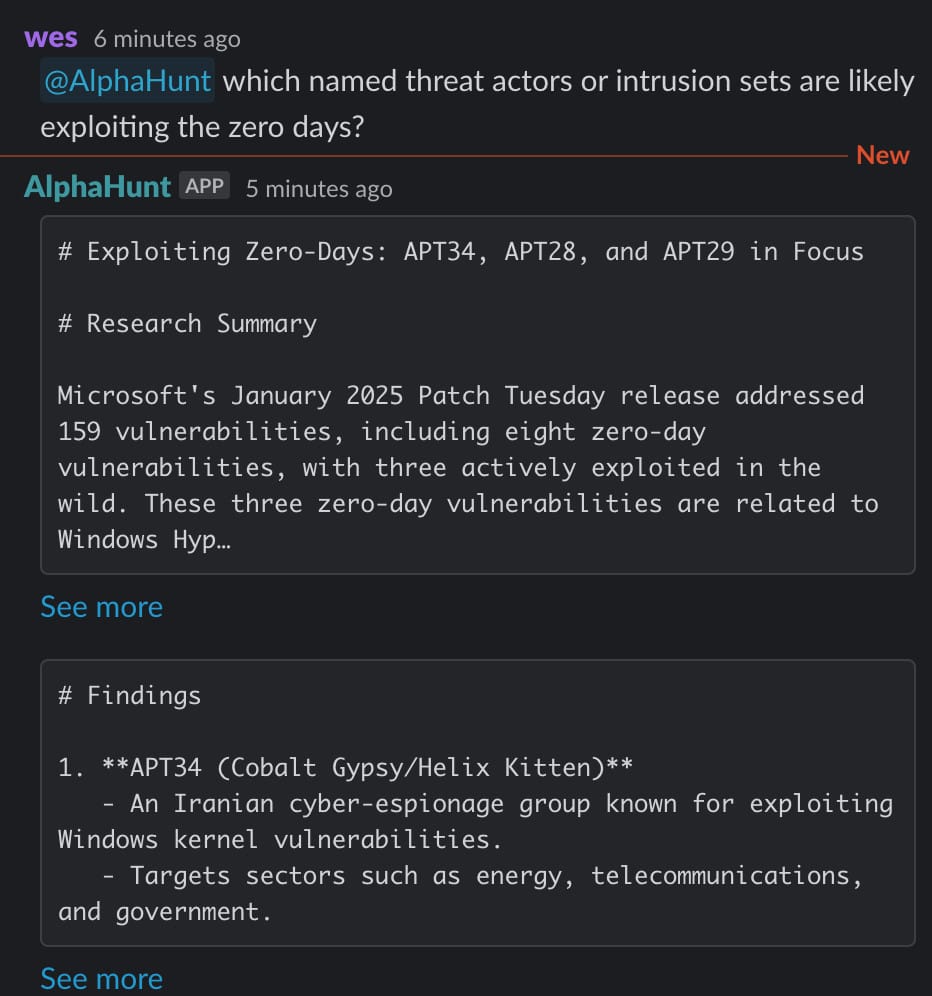Exploiting Zero-Days: APT34, APT28, and APT29 in Focus
Microsoft's January 2025 Patch Tuesday release addressed 159 vulnerabilities, including eight zero-day vulnerabilities, with three actively exploited in the wild.



a little "inside baseball"
TL;DR
-
APT34 (Cobalt Gypsy/Helix Kitten)
- An Iranian cyber-espionage group known for exploiting Windows kernel vulnerabilities.
- Targets sectors such as energy, telecommunications, and government.
-
APT28 (Fancy Bear)
- A Russian APT group with a history of exploiting elevation of privilege vulnerabilities.
- Involved in cyber-espionage campaigns targeting government agencies and defense contractors.
-
APT29 (Cozy Bear)
- Another Russian APT group known for sophisticated cyber-espionage activities.
- Targets include government agencies, critical infrastructure, and private sector organizations.
-
Motivations
- Espionage and intelligence gathering are the primary motivations behind these threat actors.
- Targeting high-value sectors to gather sensitive information.
-
Tactics
- Exploiting zero-day vulnerabilities to gain unauthorized access and elevate privileges.
- Utilizing spear-phishing and social engineering techniques to deliver malicious payloads.
-
Defense Strategies
- Prioritize patching identified vulnerabilities and implement robust security measures.
- Leverage threat intelligence to stay informed about the latest TTPs used by these groups.
-
Continuous Monitoring
- Implement continuous monitoring for suspicious activities and network anomalies.
- Use multi-factor authentication and network segmentation to enhance security.
Research Summary
Microsoft's January 2025 Patch Tuesday release addressed 159 vulnerabilities, including eight zero-day vulnerabilities, with three actively exploited in the wild. These three zero-day vulnerabilities are related to Windows Hyper-V NT Kernel Integration VSP Elevation of Privilege, allowing an authenticated user to execute code with SYSTEM privileges. The vulnerabilities, identified as CVE-2025-21333, CVE-2025-21334, and CVE-2025-21335, were disclosed anonymously and are believed to have been exploited in the same attacks. This report investigates the named threat actors or intrusion sets likely exploiting these zero-day vulnerabilities, focusing on their historical context, motivations, and tactics.
The investigation reveals that the exploitation of these vulnerabilities is consistent with the tactics of several advanced persistent threat (APT) groups known for targeting critical infrastructure and high-value targets. Notably, APT34 (also known as Cobalt Gypsy or Helix Kitten), an Iranian cyber-espionage group, has a history of exploiting Windows kernel vulnerabilities. Additionally, Russian APT groups such as APT28 (Fancy Bear) and APT29 (Cozy Bear) have been known to exploit similar elevation of privilege vulnerabilities to gain unauthorized access to systems.
The motivations behind these threat actors are primarily espionage and intelligence gathering. APT34, for instance, has been active in targeting sectors such as energy, telecommunications, and government, aiming to gather sensitive information. Similarly, Russian APT groups have been involved in cyber-espionage campaigns targeting government agencies, defense contractors, and critical infrastructure.
To defend against these threat actors, organizations should prioritize patching the identified vulnerabilities and implement robust security measures such as network segmentation, multi-factor authentication, and continuous monitoring for suspicious activities. Additionally, leveraging threat intelligence to stay informed about the latest tactics, techniques, and procedures (TTPs) used by these groups can enhance an organization's security posture.
Assessment Rating
Rating: HIGH
The assessment rating is HIGH due to the significant risk posed by the exploitation of zero-day vulnerabilities in critical infrastructure and high-value targets. The involvement of advanced persistent threat groups with sophisticated capabilities further elevates the threat level.
Attribution
Historical Context
The exploitation of zero-day vulnerabilities by APT groups is a well-documented tactic used to gain unauthorized access and elevate privileges. APT34, APT28, and APT29 have a history of targeting critical infrastructure and high-value sectors for espionage and intelligence gathering.
Countries Targeted
- United States - High-value targets in government and critical infrastructure.
- United Kingdom - Government agencies and defense contractors.
- Germany - Industrial and critical infrastructure sectors.
- France - Telecommunications and energy sectors.
- Israel - Defense and technology sectors.
Sectors Targeted
- Government - Espionage and intelligence gathering.
- Energy - Targeting critical infrastructure.
- Telecommunications - Access to sensitive communications.
- Defense - Information on defense contractors and military operations.
- Technology - Intellectual property and technological advancements.
Motivation
The primary motivation behind these threat actors is espionage and intelligence gathering. They aim to gain unauthorized access to sensitive information and disrupt critical infrastructure.
Attack Types
- Elevation of Privilege: Exploiting vulnerabilities to gain SYSTEM privileges.
- Remote Code Execution: Delivering malicious payloads to execute arbitrary code.
- Information Disclosure: Accessing sensitive information through compromised systems.
Known Aliases
- APT34 (Cobalt Gypsy/Helix Kitten)
- Iranian cyber-espionage group.
- APT28 (Fancy Bear)
- Russian APT group.
- APT29 (Cozy Bear)
- Russian APT group.
Links to Other APT Groups
-
APT33 (Elfin)
- Another Iranian APT group with similar motivations and targets.
- Known for cyber-espionage activities in the energy sector.
-
APT41 (Double Dragon)
- Chinese APT group with a history of exploiting zero-day vulnerabilities.
- Targets include government, healthcare, and technology sectors.
Similar Threat Actor Groups
-
APT33 (Elfin)
- Similar motivations and targets as APT34.
- Focus on cyber-espionage in the energy sector.
-
APT41 (Double Dragon)
- Similar tactics and techniques in exploiting zero-day vulnerabilities.
- Targets include government, healthcare, and technology sectors.
Counter Strategies
-
Patch Management
- Prioritize patching identified vulnerabilities to prevent exploitation.
- Implement automated patch management solutions.
-
Network Segmentation
- Segment networks to limit lateral movement of attackers.
- Use firewalls and access controls to restrict unauthorized access.
-
Multi-Factor Authentication
- Implement multi-factor authentication to enhance security.
- Use strong authentication methods for critical systems.
Recommendations, Actions, Suggested Pivots, Forecasts and Next Steps..
(Subscribers Only)


![[DEEP RESEARCH] Zero-Days Are a Distraction: 2025’s Biggest Losses Were Stolen Tokens + OAuth](/content/images/size/w600/2025/12/zz-3.png)


